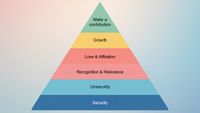The emotional needs pyramid – from creation to growth
Blog post from 2025.08.12
Damian Richter's emotional needs pyramid offers a transformative extension of the classic Maslow pyramid – a needs pyramid comprising six essential stages. These show how we gradually develop from external-oriented creation to inner growth and meaningful contribution – a model that is the key to inner freedom and lasting fulfillment.
Damian Richter's emotional needs pyramid
Damian Richter presents a powerful model that restructures our emotional inner life—away from the eternal search for external fulfillment and toward genuine inner fulfillment. The emotional needs pyramid consists of six levels on which we detach ourselves from ego-centered striving and grow into a self-determined, meaning-oriented life - step by step.
The six levels of the emotional needs pyramid
1️⃣ Level 1: Security – The foundation for everything
Security is the basis. Without a stable sense of security, people cannot sustainably fulfill higher needs. Examples of security needs:
- A safe home and reliable accommodation
- Financial stability (regular income, savings)
- Basic health care
- Protection from danger, violence, and threats
Organizations that provide security (insurance companies, employers, educational institutions) should first communicate a sense of reliability. In your personal life, you can create security by establishing routines and maintaining a stable social environment.
2️⃣ Stage 2: The inner drive for change
This stage is about consciously dealing with uncertainty - not avoiding it. Damian Richter emphasizes that uncertainty also holds potential for growth. Examples:
- Courage to start new things (change jobs, move, start a new relationship)
- Taking risks to seize opportunities
- Facing challenges instead of staying in your comfort zone
If you leave your comfort zone, you should do so with a safety net – for example, through further training or the support of mentors. This way, uncertainty becomes a driving force instead of a barrier.
3️⃣ Stage 3: Recognition & significance – being seen and valued
People long not only to “be there,” but also to have significance. Recognition can come from outside (praise, awards) or from within (self-esteem). Examples:
- Praise and appreciation at work
- Social confirmation from family and friends
- The feeling of being needed for one's talents
In the work environment, regular feedback not only increases motivation but also loyalty. In private life, it helps to be aware of the positive influence one has on others.
4️⃣ Level 4: Love & Belonging – Connection and Emotional Warmth
This is about genuine emotional closeness and the feeling of belonging to a community. Examples:
- Close friendships
- Romantic relationships and partnerships
- Family cohesion
- Belonging to groups, clubs, or teams
Actively nurture your relationships: shared experiences, open communication, and showing genuine appreciation are crucial. Isolation is a major stress factor – therefore, belonging should be consciously promoted.
5️⃣ Level 5: Growth – personal development
People want to develop and expand their skills. Stagnation can lead to dissatisfaction – “Everything that does not grow dies.” Examples:
- Further education, learning new skills
- Setting and achieving personal goals
- Implementing creative projects
- Surpassing yourself, pushing boundaries
Set yourself learning and development goals that challenge you but do not overwhelm you. Document your progress to maintain motivation.
6️⃣ Level 6: Contribute – Create meaning and give back
At the top of the pyramid is the need to serve a greater whole and have a positive influence beyond oneself. Examples:
- Volunteer work
- Mentoring and passing on knowledge
- Supporting sustainable projects
- Passing on values and experiences to the next generation
Look for opportunities to make a difference in your community – whether through donating your time, expertise, or supporting others. Contributing to something meaningful not only increases happiness, but also the feeling of connectedness.
The six levels in comparison
Level | Need | Focus |
1 | Security | External (e.g., money), but true security comes from within |
2 | Insecurity | External, but can promote inner growth |
3 | Recognition & significance | External – often leads to self-denial |
4 | Love & belonging | External – can threaten personal freedom |
5 | Growth | Internal – self-empowerment through development |
6 | Contribution | Internal – meaningful, self-responsible |
Why this model is so powerful
- Independence through self-empowerment: Instead of seeking recognition or security externally, you build both within yourself.
- Growth as an inner need: You develop continuously—from within yourself, rather than being controlled by external forces.
- Contribution as an expression of meaning and impact: You don't just live, you actively shape and support – sustainably and self-determinedly.
Comparison of the models of Maslow and Richter
- Maslow (Abraham Harold Maslow, * 1908.04.01, in Brooklyn, New York City; † 1970.06.08 in Menlo Park, California) describes a hierarchical sequence of classic needs – from basic physical needs (food, sleep, safety) to social and psychological needs to self-actualization. His model is strongly focused on survival and functioning in the outside world – “What do I need to live?”
- Richter (Damian Richter, * 1962.12.01 in Eutin, BRD) focuses on emotional development and inner freedom. His six stages (security, insecurity, recognition & significance, love & belonging, growth, contribution) show a path from egocentric needs in the outside world to self-determined action and meaning-making – “What do I need to live a fulfilled and free life?”
Conclusion
Damian Richter's Emotional Needs Pyramid shows that human motivation does not arise solely from a sense of lack, but also from a desire for growth, meaning, and connection. It is a valuable tool for personal development, coaching, team development, and life planning.
If you feel addressed here and have gained the impression that I can make a contribution to your future better life
with my coaching and mentoring, then simply contact me without obligation for a free 1:1 introductory conversation.


